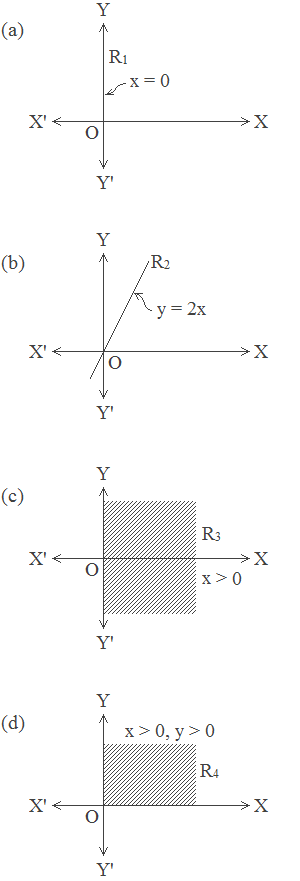
If A and B are two non-empty sets then any subset of ordered pairs of a cartesian product A × B is called a relation from set A to set B. A relation is denoted by xRy or
simply R, if (x, y) ∈ R. A relation from set A
to A is called a relation on A.
Ways of Representing a Relation
Relations can be expressed in various ways. Here are some
examples:
********************
10 Math Problems officially announces the release of Quick Math Solver and 10 Math Problems, Apps on Google Play Store for students around the world.
********************
********************
Examples:
1. By specifying or displaying a set of ordered pairs:
(a) R = {(1, 1), (2,
4), (3, 9), (4, 16), (5, 25)}
(b) R = {(1, 1), (2,
2), (3, 3)}
2. By standard description, using a rule or a formula:
(a) Let A = {1, 2, 3}
and B = {1, 4, 9}. R = {(x, y): y = x2}. Then R = {(1, 1), (2, 4),
(3, 9)}.
(b) Let A = {1, 2, 3}
and B = {1, 2, 3}. R = {(x, y): x = y}. Then R = {(1, 1), (2, 2), (3, 3)}
3. By table, such as:
(a) R = {(1, 1), (2, 4), (3, 9), (4, 16), (5, 25)}

(b) R = {(1, 1), (2, 2), (3, 3)}

4. By arrow diagram:

R = {(1, 1), (2, 4), (3, 9), (4, 16), (5, 25)}
5. By graphs:

R = {(1, 1), (2, 2), (3, 3)}
Domain and Range of a Relation
The domain of a
relation is the set of all the first elements of the ordered pairs of R, and its range is the set of all second
elements.
Examples:
1. Let R1 = {(1, 1), (1, 2), (1, 3), (2, 2), (2, 3),
(3, 3)}
Domain of R1
= {1, 2, 3}
Range of R1
= {1, 2, 3}
2. Let R2 = {(1, 2), (3, 4), (5, 6)}
Domain of R2
= {1, 3, 5}
Range of R2
= {2, 4, 6}
Types of Relation
Let us consider A = {1, 2, 3}
Then the cartesian product A × A = {(1, 1), (1, 2), (1, 3), (2,
1), (2, 2), (2, 3), (3, 1), (3, 2), (3, 3)}
(i) Reflexive Relation
A relation R is called reflexive if every element of the
relation is related to itself. It is written as xRx. For example: R1
= {(1, 1), (2, 2), (3, 3)}
(ii) Symmetric Relation
In a relation, if the first and second components of the ordered
pairs are interchanged, the relation still holds. It is called the symmetric
relation. For example: R2 = {(1, 2), (2, 1)}. It is written as if
xRy then yRx. If x = y then the relation is Anti-symmetric. e.g. R3
= {(1, 2), (1, 3), (2, 1), (3, 1)}
(iii) Transitive Relation
A relation R is called transitive if aRb and bRc gives aRc.
Thus, if a is related to b and b is related to c then a is related to c. For
example: R3 = {(1, 2), (2, 3), (1, 3)}.
(iv) Equivalence Relation
A relation is called equivalence if and only if it is reflexive,
symmetric and transitive. For example: R4 = {(1, 1), (2, 2), (3, 3),
(1, 2), (1, 3), (2, 1), (2, 3), (3, 2), (3, 1)}
Inverse Relation
A relation obtained by interchanging the first and second
elements in the ordered pairs of a relation is known as the inverse of the given relation. If R
denotes a given relation its inverse is denoted by R-1.
In symbols, if R = {(a, b): a ∈ A, b ∈ B}, then R-1 = {(b, a): b ∈ B, a ∈ A}.
Worked Out Examples
Example 1: Let A = {1, 2, 3, 4} and B = {1, 3, 5}. Find the relation R from A
to B determined by the condition ‘x < y’.
Solution: Here,
A = {1, 2, 3, 4} and B = {1, 3, 5}
Since x ∈ A, y ∈ B and x < y, R = {(1, 3), (1, 5), (2, 3), (2, 5), (3, 5),
(4, 5)}
Example 2: Find the domain, range and inverse of the relation R = {(1, 2), (2,
4), (3, 6), (4, 8)}.
Solution: Here,
R = {(1, 2), (2, 4), (3, 6), (4, 8)}
Domain of R = {1, 2, 3, 4}
Range of R = {2, 4, 6, 8}
R-1 = {(2, 1), (4, 2), (6, 3), (8, 4)}
Example 3: In the universe R × R (R is the set of all real numbers), graph (or
sketch) the relations expressed below:
(a) R1 = {(x, y) : x = 0}
(b)R2 = {(x, y) :
y = 2x}
(c) R3 = {(x, y) : x < 0}
(d)R4 = {(x, y) :
x > 0, y > 0}
Solution:
The graph of R1, R2, R3 and R4 are shown in figures a, b, c, and d respectively.




0 comments: